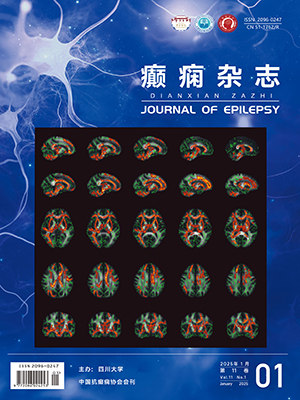| 1. |
肖花明, 王毅. 癫痫的药物治疗研究进展. 世界临床药物, 2012, 33(1): 22-24, 29.
|
| 2. |
臧玉静, 赵春玲. 与癫痫有关的细胞信号通路的研究现状. 临床与病理杂志, 2014, 34(1): 99-105.
|
| 3. |
Tran LH, Zupanc ML. Neurocognitive comorbidities in pediatric epilepsy: lessons in the lab and clinical profile. Semin Pediatr Neurol, 2017, 24(4): 276-2814.
|
| 4. |
Liu H, Yang Y, Wang Y, et al. Ketogenic diet for treatment of intractable epilepsy in adults: a meta-analysis of observational studies. Epilepsia Open, 2018, 3(1): 9-17.
|
| 5. |
Lerche H. New hope for the treatment of epilepsy. Brain, 2015, 138(Pt2): 240-242.
|
| 6. |
Ostendorf AP, Wong M. mTOR inhibition in epilepsy: rationale and clinical perspectives. CNS Drugs, 2015, 9(2): 91-99.
|
| 7. |
Brewster AL, Lugo JN, PatilVV, et al. Rapamycin reverses Status epilepticus-induced memory deficits and dendritic damage. PLoS One, 2013, 8(3): e57808.
|
| 8. |
Buckmaster PS. Does mossy fiber sprouting give rise to the epileptic state? Adv Med Biol, 2014, 813: 161-168.
|
| 9. |
Cardamone M, Flanagan D, Mowat D, et al. Mammalian target of rapamycin inhibitors for intractable epilepsy and subependymal giant cell astrocytomas in tuberous sclerosis complex. J Pediatr, 2014, 164(5): 1195-1200.
|
| 10. |
Ming GL, Song H. Adult neurogenesis in the mammalian central nervous system. Ann Rev Neurosci, 2005, 28: 223-250.
|
| 11. |
Hodges SL, Lugo JN. Wnt/beta-catenin signaling as a potential target for novel epilepsy therapies. Epilepsy Res, 2018, 146: 9-16.
|
| 12. |
Garcia AL, Udeh A, Kalahasty K, et al. A growing field: the regulation of axonal regeneration by wnt signaling. Neural Regen Res, 2018, 13(1): 43-52.
|
| 13. |
De Ferrari GV, Avila ME, Medina MA, et al. Wnt/beta-catenin signaling in alzheimer’s disease. CNS Neurol Disord Drug Targets, 2014, 13(5): 745-754.
|
| 14. |
Hoseth EZ, Krull F, Dieset I, et al. Exploring the wnt signaling pathway in schizophrenia and bipolar disorder. Transl Psychiatry, 2018, 8(1): 55.
|
| 15. |
Yang J, Zhang X, W uY, et al. Wnt/beta-catenin signaling mediates the seizure-facilitating effect of postischemic reactive astrocytes after pentylenetetrazole-kindling. Glia, 2016, 64(6): 1083-1091.
|
| 16. |
Busceti CL, Biagioni F, Aronica E, et al. Induction of the wnt inhibitor, dickkopf-1, is associated with neurodegeneration related to temporal lobe epilepsy. Epilepsia, 2007, 48(4): 694-705.
|
| 17. |
Huang C, Fu XH, Zhou D, et al. The role of Wnt/beta-catenin signaling pathway in disrupted hippocampal neurogenesis of temporal lobe epilepsy: a potential therapeutic target?. Neurochem Res, 2015, 40(7): 1319-1332.
|
| 18. |
Croll SD, Goodman JH, Scharfman HE. Vascular endothelial growth factor (VEGF) in seizures: a double-edged sword. Adv Exp Med Biol, 2004, 548: 57-68.
|
| 19. |
Madsen TM, Newton SS, Eaton ME, et al. Chronic electroconvulsive seizure up-regulates β-catenin expression in rat hippocampus: role in adult neurogenesis. Biol Psychiatry, 2003, 54(10): 1006-1014.
|
| 20. |
Pirone A, Alexander J, Lau LA, et al. APC conditional knock-out mouse is a model of infantile spasms with elevated neuronal beta-catenin levels, neonatal spasms, and chronic seizures. Neurobiol Dis, 2017, 98: 149-157.
|
| 21. |
Yang J, Zhang X, Wu Y, et al. Wnt/β-catenin signalling pathway mediated aberrant hippocampal neurogenesis in kainic acid-induced epilepsy. Cell Biochem Funct, 2017, 35(7): 472-476.
|
| 22. |
Theilhaber J, Rakhade SN, Sudhalter J, et al. Gene expression profiling of a hypoxic seizure model of epilepsy suggests a role for mTOR and Wnt signaling in epileptogenesis. PLoS One, 2013, 8(9): e74428.
|
| 23. |
Gorter JA, Iyer A, White I, et al. Hippocampal subregion-specific microRNA expression during epileptogenesis in experimental temporal lobe epilepsy. Neurobiol Dis, 2014, 62: 508-520.
|
| 24. |
Rubio C, Rosiles-Abonce A, Trejo-Solis C, et al. Increase signaling of wnt/beta-catenin pathway and presence of apoptosis in cerebellum of kindled rats. CNS Neurol Disord Drug Targets, 2017, 16(7): 772-780.
|
| 25. |
Cappuccio I, Calderone A, Busceti CL, et al. Induction of Dickkopf-1, a negative modulator of the Wnt pathway, is required for the development of ischemic neuronal death. J Neurosci, 2005, 25(10): 2647-2657.
|
| 26. |
Licht-Murava A, Paz R, Vaks L, et al. A unique type of GSK-3 inhibitor brings new opportunities to the clinic. Sci Signal, 2016, 9(454): 110.
|
| 27. |
Scott E, Brann DW. Estrogen regulation of Dkk1 and wnt/beta-catenin signaling in neurodegenerative disease. Brain Res, 2013, 1514: 63-74.
|
| 28. |
Bovolenta P, Esteve P, Ruiz JM, et al. Beyond wnt inhibition: new functions of secreted frizzled-related proteins in development and disease. J Cell Sci, 2008, 121(Pt6): 737-746.
|
| 29. |
Chen B, Dodge ME, Tang W, et al. Small molecule-mediated disruption of wnt-dependent signaling in tissue regeneration and cancer. Nat Chem Biol, 2009, 5(2): 100-107.
|




